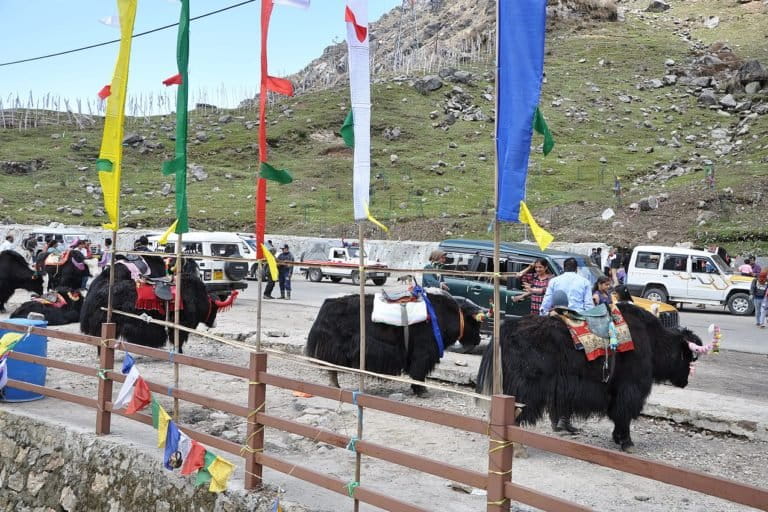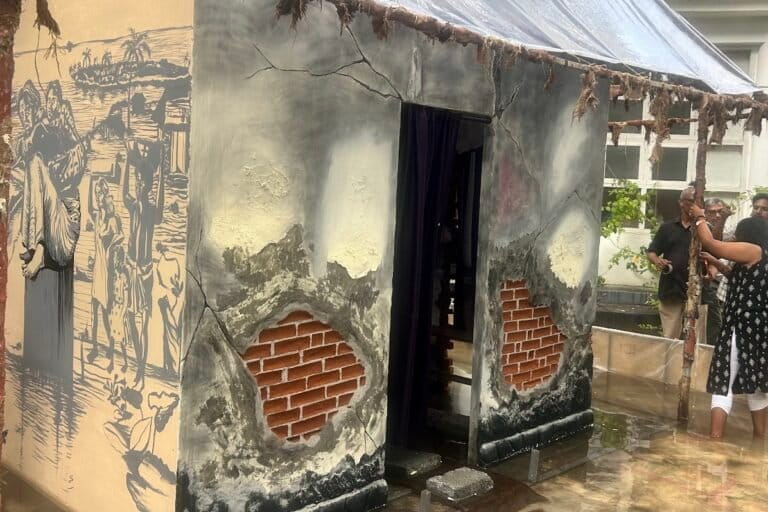- Sikkim in India is raising a yak bull gifted by Bhutan in a transboundary germplasm exchange to improve the species gene pool. Two bulls were handed over to Nepal as well.
- The exercise will facilitate the gene flow from one population to another, ensure genetic diversity in the transboundary yak population and produce healthy offspring that can produce more milk, meat, and fibre. Yak rearing has connected people in adjacent parts of Bhutan, India, and Nepal for centuries.
- Rapid development, climate change, and evolving geopolitics have affected pastoral practices by isolating herders and impacting traditional pastures, leading to the isolation of yak populations and inbreeding, causing a decline in the health of their populations.
- Registering yak breeds will also pave the way for focused conservation initiatives.
Certified disease-free and blessed by a Lama in Bhutan, Druk, a four-year-old yak bull, crossed the border and traveled to the state of Sikkim in India in February 2020, in a move that is being seen as a shot in the arm for conservation of the iconic species in the Hindu Kush Himalayan (HKH) region.
Druk was accompanied by a medical team as he made the road trip from Bhutan, for over 22 hours with rest stops, to reach the Zema Yak Breeding Station, North Sikkim, India, in a transboundary germplasm exchange facilitated by International Centre for Integrated Mountain Development (ICIMOD).
In the exchange that transpired in February-March 2020 (before the COVID-19 lockdown), Druk was brought to Sikkim, India and two other yak bulls were gifted to Nepal by Bhutan for gene pool improvement.
“Druk is healthy and is doing well. He is fed a seed concentrate for a balanced diet and is released into the department’s farm for grazing and familiarisation with the herd,” said veterinary officer Sonam Diki Lepcha, at Sikkim government’s Department of Animal Husbandry, Livestock, Fisheries, and Veterinary Services.
Nakul Chettri, regional programme manager, Transboundary Landscapes, ICIMOD, explained that the exchange of germplasm is an opportunity to facilitate the gene flow from one population to another and ensure genetic diversity in the transboundary yak (Bos grunniens) population. The yak supplied are around four years old, so they will be able to breed soon.

“With an exchange like this, the new generations will be healthy. This results in a better and healthy yak population that can produce more milk, meat, and fibre,” Chettri told Mongabay-India, adding that Bhutanese yak breeds are still less hybridised and of good genetic stock with a fairly healthy population.
Weaved into the fabric of life, the culture and economy around yak rearing have connected people in adjacent parts of Bhutan, India, and Nepal for centuries. Yak herding is a 4,500-year-old practice in the Tibetan Plateau and adjoining areas.
The transboundary movement of herders among the highlands is important for the prosperity of herding communities and for the vitality of their herds in the Kangchenjunga Landscape in the HKH region where rangelands cover almost 60 percent of the land.
Imperiled traditional pastoral practices and poorer quality yaks
However, rapid development, climate change, and evolving geopolitics have affected pastoral practices by isolating herders and impacting traditional pastures. As a result, the productivity and populations of yak are declining, noted Tashi Dorji, senior ecosystems specialist and theme leader, Ecosystem Services at ICIMOD, who lead the exchange.
Dorji explained that pastoralist communities in the highland areas thrived in the past as they had a wide area for grazing and a tradition of moving from one place to another seasonally. These movements are necessary for rotational grazing and also for the mixing of genes or germplasm among different populations coming from different areas.
“Seasonal migration is a key aspect of yak management to sync in with the availability of fodder and avoid extreme low winter temperature and summer heat. As a part of seasonal migration, the yak population of Sikkim, Nepal, and even Bhutan used to move from one country to another. Some herds even migrated towards the Tibetan part of the Republic of China,” said Dorji.
“In recent decades, such movements have been restricted due to geo-political situations. These restrictions have hindered not only access to the grazing resources but also seriously limited the exchange of genes between the herds leading to isolation of the yak populations.”
As a result, inbreeding has crept in the yak populations of Nepal, Sikkim (India), and Bhutan resulting in poorer quality yaks with low productivity in terms of milk, meat, and physical strength.
“There are also increasing reports of yak deaths every year, which may be associated with deterioration in the quality of the yak population and their reduced capacity to adapt to climate change,” said Nakul Chettri. According to media reports, about 300 yaks starved to death in Sikkim early last year.
“So, the exchange of germplasm is important to reduce inbreeding in the population and for keeping the population of yak healthy and productive,” emphasised Chettri.
Additionally, inbreeding and low-quality yak also deter herding culture.
“There is the risk of losing the diverse and rich culture if interventions are not made. Promoting gene exchange to increase yak productivity, strengthening yak value chains as well as transboundary yak festivals will contribute to creating more awareness and appreciation to the rich traditional cultures. It will also generate policy support to ensure preserving the yak culture.”
An Indian government report underscores the warming in the HKH region with a temperature rise of about 1.3 degree Celsius observed during 1951–2014. It said that the future warming in the HKH region, “which is projected to be in the range of 2.6–4.6 degree Celsius” by the end of 2100, “will further exacerbate the snowfall and glacier decline leading to profound hydrological and agricultural impacts in the region.”
Building on learnings and dialogues
A series of dialogues between the multicountry stakeholders and the acquisition of necessary approvals set the ball rolling for the exchange in 2018. Bhutan’s livestock department took the initiative to select the best five bulls aged 3-4 years from herds in the country’s Haa and Paro districts, factoring in weather conditions in North Sikkim and northeastern Nepal where the bulls are being raised.
“The technical parameters include a number of criteria particularly on disease-free status at the source, habitat, and animals themselves,” added Dorji, adding the exercise was aligned with live animal import regulations laid down by the government of Nepal and the state government of Sikkim.
The current yak exchange builds on the learnings from a 2005 bilateral yak exchange between Sikkim and Bhutan (without ICIMOD) in which Sikkim received 30 good-quality yaks from Bhutan. The offspring with parents from Bhutan showed increases in body size, body conformation, inter-calving period, and milk yield.

This success, according to an ICIMOD issue brief Protecting a Himalayan icon: The need for transboundary cooperation to secure the future of yak in the Kangchenjunga Landscape, demonstrates the effectiveness of cross-border cooperation in countering the genetic degradation arising from the restricted movement of yak between countries.
Apart from Sikkim, in India, the yak-rearing states include Arunachal Pradesh, Uttar Pradesh, Himachal Pradesh, and the former state of Jammu and Kashmir. Current government estimate puts the total yak population in the country at 58,000.
A range of policies and legislations govern practices key to yak management, such as grazing, in India, Nepal, and Bhutan. Sikkim, in India, banned open grazing in protected areas in 1998.
Selective enforcement of this ban in the mountainous part of Khangchendzonga National Park resulted in the eviction of agropastoralists from protected areas adjacent to the park in West Sikkim by 2002. This resulted in conflicts between yak herders and park management.
In North Sikkim, yak herding continues under the Dzumsa system. Dzumsa is a traditional institution in the Lachen and Lachung valleys of North Sikkim. The Dzumsa, the local body that governs the indigenous communities (Lachenpas and Lachungpas), decides the migration track and time so as to conserve pastures at high altitudes through a rotation policy. The Dzumsa fixes the date of movement for all herders according to the Tibetan lunar calendar and manages the rangeland resources by rotational grazing practices.
Read more: How the yak rearing system in north Sikkim is coping with climate change
Registering yak breeds for future collaborations
Chettri and Dorji expressed optimism on scaling up the exchange in the Kangchenjunga Landscape, informing that Nepal and Sikkim have assured sharing their best germplasm with Bhutan in the near future. As India has already developed yak semen processing and artificial insemination technology, concerted effort will be made to adapt these technologies across the landscape for up-scaling genetic exchange initiative, they said.
Commending the exchange effort, animal physiologist Vijay Paul of ICAR’s National Research Centre on Yaks said registering breeds of yak would supplement such efforts through customisation of conservation efforts for specific breeds and building on their numbers.
In 2018, Arunchali yak, native to West Kameng and Tawang districts of Arunachal Pradesh, was successfully registered as a distinct breed. They are predominantly black in colour with a medium-sized and compact body and have a high-fat content in their milk. “Similar, such breed characterisation and registration should be taken up for yak populations in Sikkim and other states,” Paul told Mongabay-India.
Banner image: Yak bulls blessed by Lama in Paro, Bhutan before traveling to India and Nepal. Photo by Jitendra Raj Bajracharya/ICIMOD.













